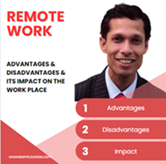Introduction:
The modern workplace has evolved significantly, driven by technological advancements, changing demographics, and evolving work practices. In this essay, we will explore the advantages and disadvantages of various aspects that have a profound impact on the workplace. We will discuss the implications of technology, diversity, and remote work, shedding light on their effects and the challenges they pose.
Advantages of Technology in the Workplace:
Increased productivity: Technology has streamlined processes, automated tasks, and improved efficiency, allowing employees to accomplish more in less time.
Enhanced communication: Communication tools such as email, video conferencing, and instant messaging facilitate seamless collaboration, irrespective of geographical boundaries.
Access to information: The internet and digital databases provide instant access to vast amounts of information, empowering employees to make informed decisions and stay updated in their respective fields.
Flexibility and mobility: Technology enables remote work, flexible hours, and the ability to work from anywhere, giving employees more autonomy and improving work-life balance.
Automation of mundane tasks: Automation technologies reduce the burden of repetitive tasks, freeing up employees to focus on more complex and strategic activities.
Disadvantages of Technology in the Workplace:
Dependency and technical issues: Overreliance on technology can lead to disruptions when systems fail or encounter technical glitches, causing delays and frustration.
Reduced face-to-face interactions: Increased reliance on digital communication may erode personal connections and hinder effective teamwork and relationship-building.
Cybersecurity threats: The digital landscape presents security challenges, such as data breaches and cyber-attacks, which can compromise sensitive information and disrupt operations.
Technological skills gap: The rapid pace of technological advancement requires employees to continually upgrade their skills, which can be challenging for those who struggle to adapt or lack access to training resources.
Potential job displacement: Automation and artificial intelligence have the potential to replace certain job roles, causing uncertainty and job insecurity for some employees.
Impact on the Workplace:
Workforce diversity: Embracing diversity in the workplace brings together individuals with different perspectives, backgrounds, and experiences, fostering creativity, innovation, and problem-solving.
Inclusion and belonging: A diverse workforce promotes a sense of inclusivity, making employees feel valued, respected, and engaged, leading to increased motivation and productivity.
Broader talent pool: Organizations that prioritize diversity attract a wider range of candidates, increasing the likelihood of hiring highly skilled and qualified professionals.
Cultural competence: Exposure to diverse colleagues enhances cultural understanding and sensitivity, fostering an inclusive and culturally competent work environment.
Communication challenges: Diversity can present communication barriers, such as language differences and varying communication styles, requiring organizations to invest in effective cross-cultural communication training and tools.
Conclusion:
Advancements in technology, the embrace of diversity, and the adoption of remote work have both positive and negative impacts on the workplace. While technology enhances productivity and connectivity, it also poses challenges like dependency and cybersecurity risks. Diversity brings various benefits, but it also requires organizations to navigate communication and inclusion challenges. Understanding the advantages and disadvantages of these factors is essential for organizations to create a thriving and inclusive workplace that harnesses the benefits while mitigating the potential downsides. By adapting and leveraging these aspects effectively, organizations can optimize their work environment and drive success in a rapidly changing world.
